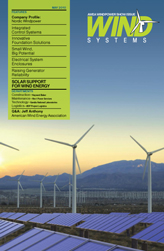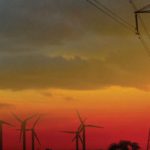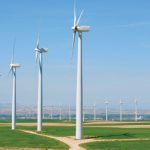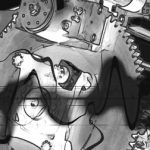As most people know, the Texas Panhandle is an ideal place for wind energy. With Competitive Renewable Energy Zone (CREZ) high voltage transmission lines scheduled for completion by the end of 2012, wind power plants should begin to pepper the region. Texas Tech University is in the ideal location, boasting the only doctorate program in Wind Science and Engineering, and the only graduate certificate program in the wind energy industry. Here at the Wind Science and Engineering (WiSE) Research Center students are addressing “everything wind,” from tornados, hurricanes, and the damage they inflict to multifaceted wind energy research and education. Some current projects are titled Turbulent Far-Wake Development behind Wind Turbines, Innovative Gearbox Design for Reliability, Turbulence-Driven Gear and Bearing Test Systems, Quantifying Effects of Turbulence from Large-Scale Wind Energy Development on Local area Microclimate, and Firming Wind Energy with solar Photovoltaic (PV).
Independent system operators of various electrical grids have long been adept at handling the variability of the electric load. However, there is greater renewable energy penetration into the grids than ever before. Combining the variability of the electric load with the variability of intermittent generation sources such as solar and wind is creating a greater challenge for grid operators. By combining wind and solar PV on a utility scale, the uncertainty of generation is greatly reduced and a more reliable energy source is created.
On average wind energy is best at night, when the atmosphere is stable. While there are times when the wind does blow during daylight hours, wind energy tends to produce less during the day when the atmosphere is unstable due to solar heating. Solar PV energy is only available during the day, when the sun is shining and atmospheric mixing takes place. By combining these two inexhaustible and renewable resources, a single power plant can take advantage of Mother Nature and produce more-reliable and less-intermittent power.
Texas Tech operates one of the only 200-meter towers specifically utilized for atmospheric data collection as well as a 58-station MesoNet—learn more at www.mesonet.ttu.edu—that records a plethora of data above and below the surface at five-minute intervals for public use. By utilizing data from the 200-meter tower at heights equivalent to the blade-swept area of large wind turbines and the nearby Reese MesoNet station’s solar radiation data, times of intermittency can easily be identified. Currently in the early stages of research, analysis of the first six months of 2009—an average wind and solar year—has produced some interesting results.
For wind energy, times of intermittency were relatively small since the winter and spring months produce the best winds. A five-minute time scale is used since some electric grids will be converting to a “smart grid,” which utilizes increments of that same length. Over the first six months there were 640 occurrences of too-low or no wind which lasted from five minutes to one hour, 40 occurrences of no wind power production from one to two hours, 17 occurrences from two to three hours, 11 occurrences from three to four hours, and 19 occurrences of greater than four hours. A five-minute breakdown of nonproductive wind occurrences can be seen in (Figure 1
Over the same time period in 2009, times of no solar energy, sunset to sunrise, ranged from nine to 14 hours. By combining the two data sets, the synergy is quite obvious. Times of no energy production from either wind or solar dropped by 50 percent or more for each time. Periods of no energy production from five minutes to an hour dropped to only 300 occurrences, from one to two hours occurred 18 times, two to three hours occurred 10 times, and greater than three hours only occurred 13 times. Figure 2 shows a five-minute time scale of the combined data.
Wind and solar’s combined output also shows their collective advantage. Given a one-megawatt wind turbine and one megawatt of solar panels placed immediately south of the turbine, they can both utilize the same pad mount transformer and electrical collection system, reducing installed costs. While periods greater than one megawatt did occur, they were only for short periods of time. For prolonged times of overproduction, either the wind power or solar power production would need to be curtailed to protect the transformer equipment. To take advantage of this dual “bonus” production, a larger transformer could be utilized. However, there would be greater energy loss when production would be lower than 50 percent of the transformer’s capabilities. The losses during low production times could be greater than the added production by utilizing the larger transformer.
During the winter months when wind energy is greatest and solar energy is at its lowest maximum, the colder temperatures would allow the transformer to be slightly “overtaxed” to capture more than the allowed energy without the transformer overheating and losing efficiency. During windy summer days, this would not be the case.
Figure 3 shows the synergy that wind and solar produce together. Expecting a smooth bell curve centered on 1,000 kilowatts, the data does not support this with a smooth transition. Instead, there is an abrupt change shown by the tremendous difference between the 900 and 950 kilowatt values and the 1,000 and 1,050 kilowatt values. These abrupt changes negated the standard curve with longer transitions over time and exemplified the benefit of combining wind and solar power together. As both the wind and solar production values should be evenly distributed, the greatest concentration of values should be toward the middle, with smaller “tails” located at the maximum and minimum values. Together, however, because of the “clock-time” of the recorded values, they match precisely, creating a large pronounced peak at one megawatt. This demonstrates how decreasing wind energy values during the morning hours matches with increasing solar energy values, as well as full solar energy during the day coupled with full wind energy during the night. This is similar to two gas-turbine engines operating in tandem, as one is turned up and down and the other is adjusted opposite the first. By pairing the two individual one-megawatt systems that have nearly opposite production phases, a gross capacity factor of 0.608 was attained when not curtailing either wind or solar.
By combining wind and solar power plants, the whole is greater than the sum of its parts, and the intermittency of renewable energy is significantly reduced. The Texas Panhandle has considerable amounts of both inexhaustible resources. Once the CREZ lines are operational, there is no reason not to see more reliable renewable energy power plants being constructed. The only question remaining is: Why not take advantage of Mother Nature?
Note: The author is a fellow in the Integrative Graduate Education and Research Traineeship (IGERT) program of the National Science Foundation.







































